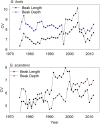Hybridization increases population variation during adaptive radiation
- PMID: 31659024
- PMCID: PMC6859339
- DOI: 10.1073/pnas.1913534116
Hybridization increases population variation during adaptive radiation
Abstract
Adaptive radiations are prominent components of the world's biodiversity. They comprise many species derived from one or a small number of ancestral species in a geologically short time that have diversified into a variety of ecological niches. Several authors have proposed that introgressive hybridization has been important in the generation of new morphologies and even new species, but how that happens throughout evolutionary history is not known. Interspecific gene exchange is expected to have greatest impact on variation if it occurs after species have diverged genetically and phenotypically but before genetic incompatibilities arise. We use a dated phylogeny to infer that populations of Darwin's finches in the Galápagos became more variable in morphological traits through time, consistent with the hybridization hypothesis, and then declined in variation after reaching a peak. Some species vary substantially more than others. Phylogenetic inferences of hybridization are supported by field observations of contemporary hybridization. Morphological effects of hybridization have been investigated on the small island of Daphne Major by documenting changes in hybridizing populations of Geospiza fortis and Geospiza scandens over a 30-y period. G. scandens showed more evidence of admixture than G. fortis Beaks of G. scandens became progressively blunter, and while variation in length increased, variation in depth decreased. These changes imply independent effects of introgression on 2, genetically correlated, beak dimensions. Our study shows how introgressive hybridization can alter ecologically important traits, increase morphological variation as a radiation proceeds, and enhance the potential for future evolution in changing environments.
Keywords: Darwin’s finches; beaks; hybridization; introgression; speciation.
Conflict of interest statement
The authors declare no competing interest.
Figures





References
-
- Lewontin R. C., Birch L. C., Hybridization as a source of variation for adaptation to new environments. Evolution 20, 315–336 (1966). - PubMed
-
- Svärdson G., “Significance of introgression in coregonid evolution” in Biology of Coregonid Fishes, Lindsey C. C., Woods C. S., Eds. (University of Manitoba Press, Winnipeg, 1970), pp. 39–59.
-
- Abbott R., et al. , Hybridization and speciation. J. Evol. Biol. 26, 229–246 (2013). - PubMed
-
- Taylor S. A., Larson E. L., Insights from genomes into the evolutionary importance and prevalence of hybridization in nature. Nat. Ecol. Evol. 3, 170–177 (2019). - PubMed
-
- Grant P. R., Grant B. R., Phenotypic and genetic effects of hybridization in Darwin’s finches. Evolution 48, 297–316 (1994). - PubMed
Publication types
MeSH terms
LinkOut - more resources
Full Text Sources

